Seared Duck Breast with Pomegranate Juice Reduction
The cooler months are upon us, and one of the most colorful and healthiest ingredients for this time of year is the pomegranate. Fall and winter seasonal foods might sometimes seem a little bland -- parsnips, cabbage, potatoes, squash. Pomegranates, in season from roughly September to January, offer a striking contrast with their brightness in flavor and color. The folks at POM Wonderful were kind enough to send us a case of POM Wonderful 100% pomegranate juice, and an invite to enter their blogger recipe contest if we were so inspired. They didn't have to ask twice.
In keeping with the seasonal theme, I created a seared duck breast, with a flavorful reduced pomegranate juice sauce. The duck was served over a "nest" of duck fat fried matchstick potatoes, and the plate was garnished with a scattering of fresh pomegranate arils.
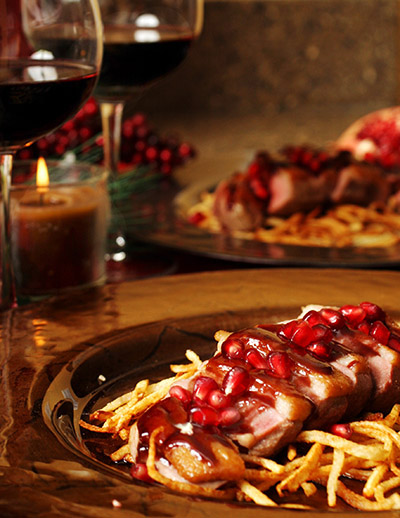
Okay, so an "aril" is the technical term for the pomegranate seed-plus-juice-and-casing. Using the term "seeds" is a little misleading as some people chew and eat the actual seeds along with the juice, while some work on the juice and refrain from eating the seed.
When working on this recipe, I was wondering why the pomegranate is still considered something of an exotic ingredient, especially as I fondly remember them from childhood. It is a little difficult to break into one, true, and there is the whole seed vs. no-seed preference, but there are other exotic fruits that have become a culinary mainstream in the last couple decades. Kiwi fruit is a good example -- odd and difficult to peel when they first appeared in grocery stores, but now they're everywhere. And pomegranates themselves have been around forever. Most of the mythology of the Western world revolves around pomegranates, from Persephone trapped in the underworld, to the possibility that it was a Mediterranean pomegranate that Eve tempted Adam with, not a northern, cold-weather apple.
There are even common ingredients that were once pomegranate based. Grenadine is a good example in mixology, used from Shirley Temples to tequila sunrises. Once, grenadine was made from pomegranates (grenade is the French word for pomegranate), but these days most grenadines are nothing more than flavored, colored corn syrup.
But, enough with the musing backstory, on with the recipe. The meal itself, just by its classical French background, may sound daunting, but really, this is a pretty approachable recipe for cooks of just about any level. There may be a few steps to this meal, but there really is nothing in this dish that requires split-second timing or arcane equipment. A little confidence, attention to a couple pots and pans, and a surprisingly complex meal can be made in an acceptable amount of time. Christey's photography does a great job of walking through each step.
Once I tasted the POM juice, I knew it would make a wonderfully flavorful, thick reduction. I considered some exotic seasonal ingredients like venison, but I figured I'd take a crack at one of my favorite cool weather proteins -- duck. Duck itself is traditionally paired with strong fruits in a variety of different ways, from the classic French standard of duck a l'Orange, to duck paired with raspberries, cherries, or plums. Pomegranate juice tastes like pomegranates, of course, but there are hints of cherry, cranberry, and raspberry, all of which make wonderful duck pairings. And for me, of course, the sauce is what makes the meal.
The sauce itself is made from POM 100% pomegranate juice, chicken stock, brown sugar, champagne vinegar (or any white wine vinegar), a medium-sized shallot, lemon rind, peppercorns, a splash of olive oil, and some salt.
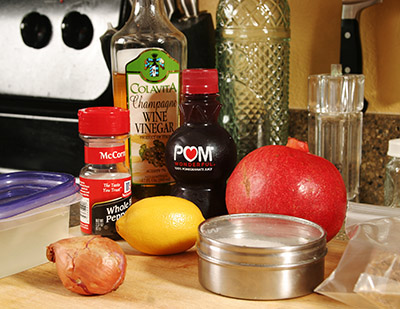
The sauce is started by chopping a medium shallot into slices and browning slowly in a bit of olive oil over medium heat. This takes about 10-15 minutes, and poking them a bit with a wooden spoon every couple minutes helps, especially near the end. The browning/caramalization process releases a flood of flavor that will create a great "aromatic" base for the sauce.
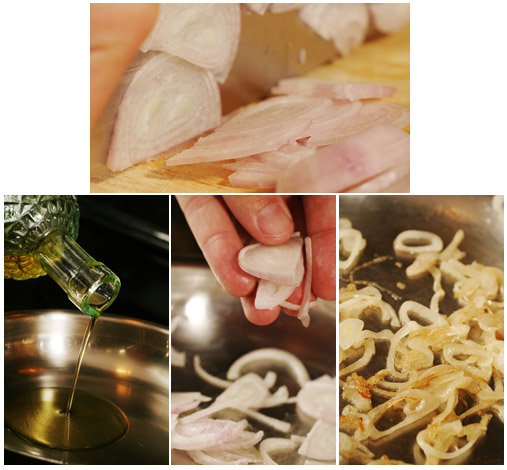
Once the shallots are golden brown, a cup of chicken stock was added to the pan, along with a cup of POM 100% pomegranate juice. Additionally, a tablespoon of champagne vinegar, 8-10 black peppercorns, and a tablespoon of brown sugar were stirred in. I also took a packed teaspoon of zest off of a lemon -- just the yellow part of the skin, none of the white underneath -- and added it to the sauce. Once the juice and stock started to bubble, the heat was reduced to low. There are roughly two cups of liquid in the pan, but it will eventually reduce (and thus seriously concentrate the taste) into about 1/2 cup. Boiling will shatter a lot of the flavor, however, due to a lot of chemical reactions that occur at high temperature. So, it's important to make sure there are gentle, lazy bubbles, but nothing that would spatter liquid out of the pan.
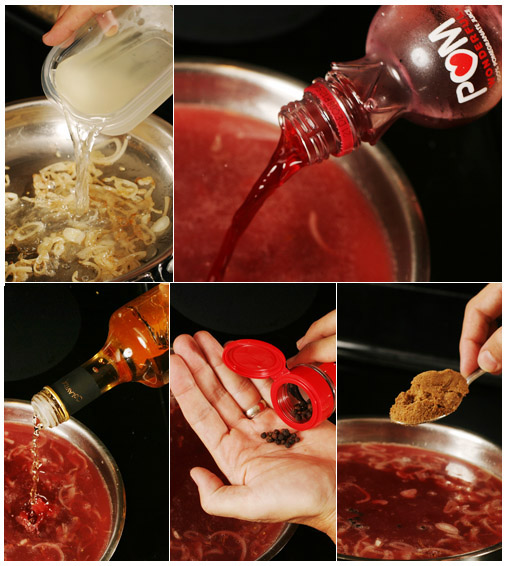
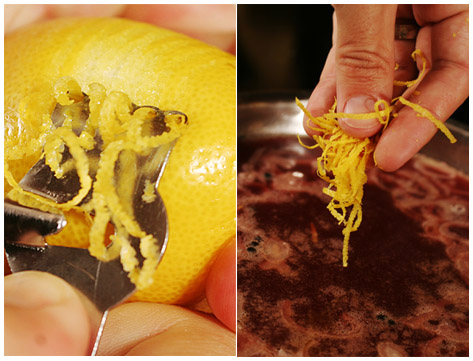
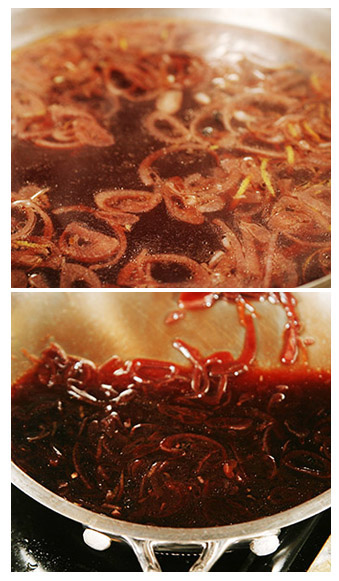
This is the reason we start with the sauce -- it's going to take 30-40 minutes to reduce the sauce by that much at a simmer, so the sauce can gently bubble, literally "on the back burner", while other parts of the recipe are coming together.
For the next bit of prep-work, I used a medium-sized Idaho potato, and sliced it on my mandolin into "matchstick frites" -- potato sticks about the thickness of a fireplace match. I happen to have acquired a mandolin after my Dad bought one and then nicked his fingertips too many times. They do tend to be out for blood sometimes! However, a mandolin is by no means necessary. It doesn't take advanced calculus to slice potatoes into matchstick-thick spears, the French have been doing it by hand for centuries. A good trick, though, is to put the finished spears in a bowl of ice water. The cool water will keep the potatoes from oxidizing and turning brown.
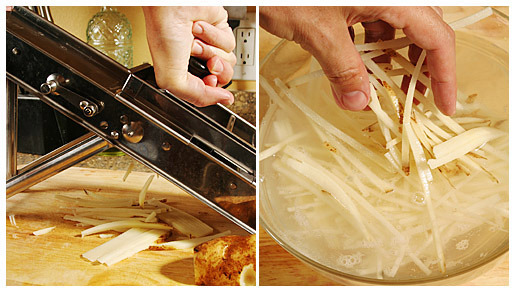
Similarly, prepping the duck breasts isn't that difficult. I couldn't find fresh duck breast where I live, but I was able to find frozen. After thawing, I sliced the skin every half-inch or so just through the skin and fat, not into the meat. The idea is that as the duck is sautéed, the duck fat will escape through the cuts (ducks have a lot of insulating fat under the skin), which will help beautifully crisp the skin (think of that wonderful, golden Thanksgiving turkey).
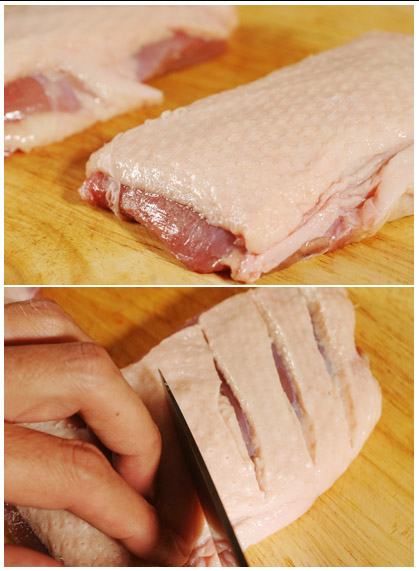
The duck is going to be cooked in two stages, which is a trick restaurants use. The first stage will sear the skin and cook the top ("presentation") side of the duck. It'll also release a lot of fat that we're going to use later. At this point, the duck can be kept off to the side until later, when we're closer to serving. But in the meantime, it allows us to move on, and the pre-cooking will speed things up later.
So, a pan is heated over medium-high heat with nothing in it until it's hot. A good test -- if you wet your fingertips and flick a little water into the pan and the water droplets skitter and dance on top of the pan, that's where you want to be. A thin glaze of olive oil is added to the pan (a teaspoon or so), spread around, and immediately, the duck goes skin-side down. Other than keeping the sauce from seriously boiling, this is the only part of the recipe that takes a bit of attention -- the duck will sizzle and spatter, but it shouldn't smoke (steam is fine -- if it smells bitter, it's smoke, if it smells good, it's steam). Peeking is okay, take some tongs and lift a corner of the duck. The skin will turn golden fairly quickly. What we're looking for is that the thick layer of fat under the skin "renders out" to a pool of liquid in the pan. It'll be pretty much skin against meat, just like a chicken or turkey. The red breast meat will turn poultry-white about 1/4-1/3 inch or so up the side of the meat. Not quite half the breast.
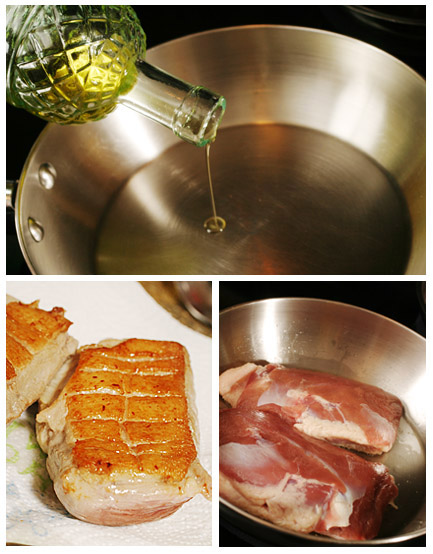
The duck breasts are removed off to the side until we're ready to finish them later. In the meantime, the pan is now filled with duck fat. Fat may be a dirty word these days, but bear with me until the end, because it's not as bad as it seems. The oven should be turned on to 400 degrees for to finish the duck later, and while it preheats, we're going to make some seriously tasty fries.
The potatoes have been chilling in the ice water bath, waiting to meet their fate. The duck fat rendered from the breasts is moved to a smaller pan, and some peanut oil is added to top off the pan a bit.
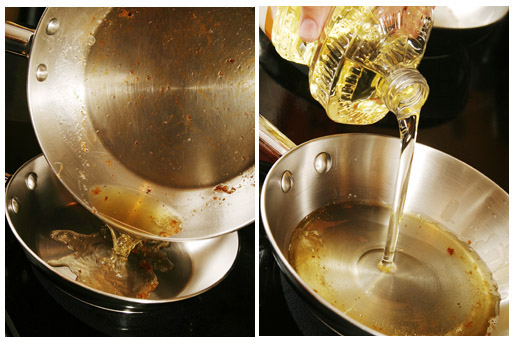
The potatoes are dried in a paper towel, then added to the pan of oil to fry into crispy loveliness. Fry until golden, then remove onto paper towels and dust liberally with salt. It took me three separate batches for one potato's worth of spears.
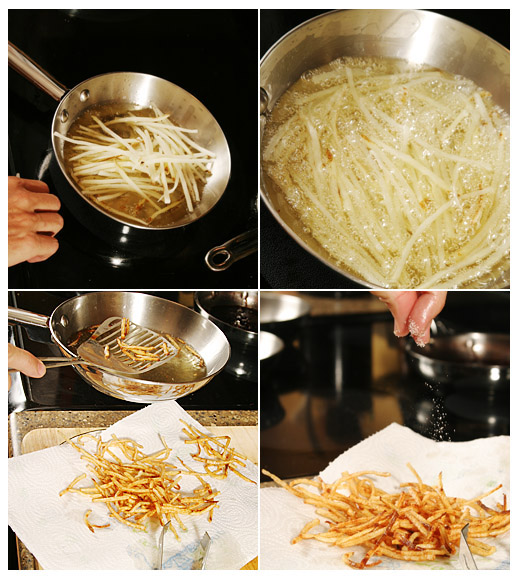
At this point, there's nothing left except sauce and the second half of the duck breast cooking. The sauce should be well on its way to 1/2 cup. Once it reaches that point, it should be removed from heat, and the duck breasts are ready to finish. Any leftover oil left in the original pan is enough -- the pan is heated again over medium-high and the duck breasts are now placed in skin-side up. Once they begin to sizzle, the duck breasts, pan and all, are put into the 400 degree oven for 10 minutes.
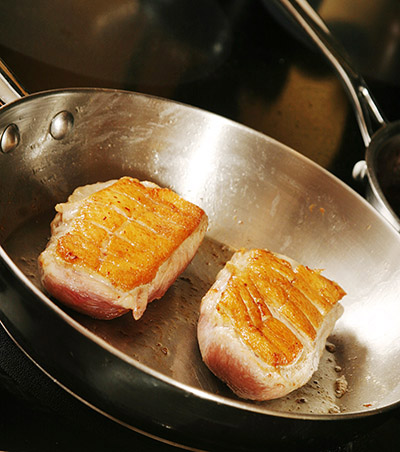
When 10 minutes are done, the pan is removed from the over, and the duck breasts are put off to the side on a plate to rest a bit. There should be a little bit more duck fat in the pan. A teaspoon or so of flour is added to the pan to make a roux -- a common thickener in sauces and gravies.
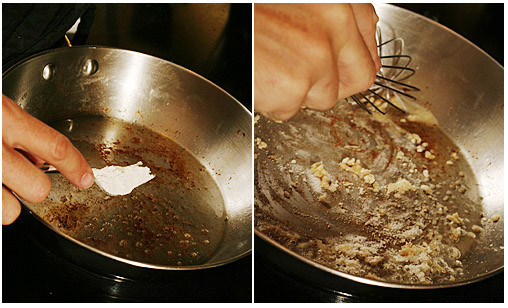
Once this is stirred together and fat and flour incorporated together, the reduced sauce is poured through a strainer, to remove the shallots, peppercorns, and lemon rinds, into the roux. Whisk, whisk, whisk over low heat, and the roux will thicken this extremely concentrated burst of flavor into a beautiful, thick, silky, shiny sauce.
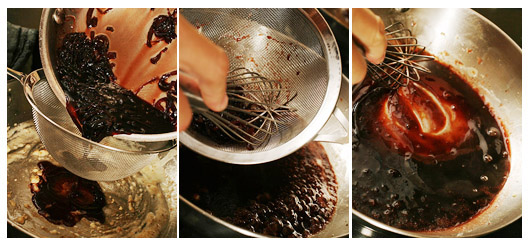
The duck is sliced at an angle, roughly along where the skin was scored earlier. It may still be red or pink in the center -- that's okay with duck! Duck can be served medium rare or even rare if that's your taste, there are no salmonella problems with duck like there may be with chicken. Personally, I like medium, where the center is pinkish-red and juicy, but not too far either way.
For plating, the matchstick fries are heaped in the center of the plate, the duck slices are arranged over the top, and the sauce is drizzled over the duck. Pomegranate arils are scattered over the plate for texture and taste as well as color.

Deconstruction: This was probably one of the best tasting duck meals I've ever made. The pomegranate created a seriously complex level of flavor, especially given the amount of concentration by reducing 100% juice and stock to roughly 1/4 volume. The hints of sweet cherry and raspberry and the cranberry-like sourness, along with the smooth, syrupy texture, contrasted wonderfully with the crispy duck skin and potatoes, and the earthy taste and texture of the duck. The crunchy and juicy pomegranate arils created pockets of flavor and texture as well.
But, it seems like there's a lot of fat in this dish, and that may be a little worrying to health-conscious foodies. There are two real arguments against that.
First, is the moderation argument, which is my personal favorite. This type of meal is not an everyday dinner at FotoCuisine HQ. Once a month, once every few weeks, a little all-out excess is a pleasurable indulgence.
Second, however, is the health benefits of many of the ingredients in this dish. The pomegranate itself is widely accepted as being full of antioxidants, as well as being medically proven to improve cardiovascular health. Duck fat, as well, is becoming more acceptable among chefs for a variety of reasons beyond the astounding taste. The French are perhaps the largest consumers of duck fat, and rank second in the world, after the Japanese, when it comes to cardiovascular health. Duck fat has been shown to improve HDL (the "good" cholesterol), and may be second to olive oil when it comes to healthy oils -- it's certainly less damaging than dairy fats, from butter to heavy cream. Paired with the fruitiness of the pomegranate, duck is a solid choice for the holiday season.
Recipe/List of ingredients:
Sauce: 1 cup POM Wonderful 100% pomegranate juice 1 cup chicken stock (I make my own, use low sodium if canned) 1 tbsp champagne vinegar (or any white wine vinegar) 1 tbsp brown sugar 8-10 black peppercorns, whole 1 packed tsp zest of lemon 1 medium shallot, sliced 1 tsp olive oil salt to taste 1 tsp flour with leftover duck fat (to make a roux)
Seared duck breasts 2 duck breasts, skin and fat scored 1 tsp olive oil salt to taste handful of pomegranate arils for garnish
Matchstick potatoes 1 Idaho potato, sliced into matchstick-thick spears Duck fat from sautéed breasts Peanut oil to top off salt to taste
Techniques of cooking outlined in post above.



